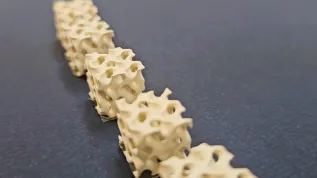
Greater measurement accuracy, a wider range of tests, full sample safety and high resistance of the sensor to mechanical damage - these are the advantages of using a synthetic diamond in the sensor developed at Gdańsk University of Technology.
Researchers from the Department of Metrology and Optoelectronics of Gdańsk University of Technology have developed a prototype fibre optic sensor for measuring basic physical and biochemical values on a micro scale. The sensor uses interference of light reflected from the artificial diamond layer.
"Diamond as such is transparent. Diamonds shine beautifully, but you can see the world through them. But in this case we use a diamond as a mirror" - explains Dr. Robert Bogdanowicz, head of the laboratory in which the artificial diamond is obtained. "This is not a trivial solution" - he adds.
Dr. Małgorzata Jędrzejewska-Szczerska, head of the team working on fibre optic sensor designs, draws attention to the imperfections of the traditional solution, in which the reflecting surface is a layer of silver or gold. "This presents many problems in the study of biological samples. Firstly, silver is a material that affects the viability of biological samples, for example by poisoning them. On the other hand, it is not very resistant to mechanical and chemical damage" - she says.
According to Dr Jędrzejewska, using a diamond as a reflecting layer has many advantages: "Firstly, it is a biocompatible material, which means that it is not damaged by biological samples, but does not poison any of these samples either. It is very resistant to mechanical and chemical damage".
Dr Jędrzejewska emphasizes another advantage resulting from the use of a synthetic diamond: "The use of a diamond layer also led to a significant reduction in the sample size - from millilitres to microlitres".
"Combining fibre optic technology with innovative materials allows us to build sensors on a completely different scale" - adds the scientist - "For example, we build temperature, pressure or displacement sensors on single optical fibres whose internal diameter can be only 8 micrometres. The sensor layer can be smaller than hundreds of nanometers. We can not even see the sensor with the naked eye - and it can still measure temperature, displacement or pressure".
The range of potential applications of such precision sensors is very wide. An example may be medical diagnosis. Fibre optic sensor even allows to study physical and biochemical parameters of individual cells. It is possible to move away from collecting large blood samples and test blood based on a small drop.
According to Dr. Robert Bogdanowicz, it is no coincidence that the idea of combining optic technology with the unique properties of synthetic diamonds was born at Gdańsk University of Technology. It is the result of a combination of experience and cognitive invention of two research teams working in one building.
He admits that the number of teams working in the world on the synthesis of synthetic diamonds is limited. "This is a very specific solution, scientists have been working on it for many years and the diamond is still a mystery to us". (PAP)
gka/ zan/ kap/
tr. RL













